GALLUP NEWS SERVICE
PRINCETON, NJ -- About 6 in 10 Americans are overweight, according to a recent Gallup survey that calculated the body mass index (BMI) of Americans based on their reported height and weight. But just 4 in 10 think of themselves that way. Moreover, if all Americans reached what they identify as their "ideal" weight, 36% would still be carrying too many pounds, including 2% who would be classified as obese.
These figures are little changed from last year, but they reaffirm that despite all of the diet fads and warnings by health professionals about the dangers of being overweight, little progress has been made in reducing one of the most serious health risks.
The survey, conducted Nov. 7-10, shows that 59% of all Americans can be classified as overweight in 2004, compared with 55% in 2003 and 54% in 2001. The differences are well within the margin of error, and should not be interpreted as showing a significant increase over the past several years. However, it is clear that there has been no improvement either.
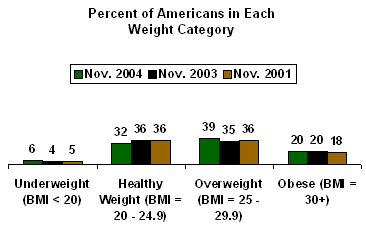
These figures are based on the method used by the National Institute of Diabetes and Digestive and Kidney Diseases (see Related Items) to measure how healthy a person's weight is. A person's reported weight and height are translated into a BMI score (see Related Items), which is essentially a ratio between the two measures. BMI scores of less than 20 are considered underweight; scores of 20 to less than 25 are considered acceptable; and any score of 25 or greater suggests the person is overweight. A score of 30 or higher suggests the person is obese, with potentially severe health problems as a consequence. These calculations are based on individuals' self-reports of their height and weight. It is possible that there is a tendency for Americans to underreport their weight and perhaps -- for men in particular -- to overreport their height, suggesting that these BMI figures may understate the true percentage of people who are overweight.
Nevertheless, the estimates of overweight adults suggested by the BMI are far higher than self-reports of being overweight. Just 41% of Americans overall say they weigh too much, including only 5% who say they are "very" overweight.
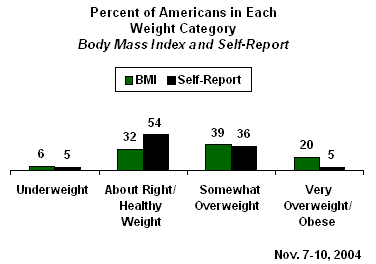
These self-reports have fluctuated very little over the past decade, though Americans are somewhat less likely to say they are overweight today than they were in 1990.
More Overweight Men Than Women; But Fewer Men Trying to Lose Weight
Men are more likely to be classified as overweight according to the BMI than are women -- 68% of men compared with 50% of women.
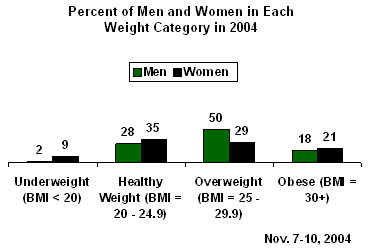
Though men are more likely to be overweight, fewer men say they want to lose weight (56%) than women (67%). These results are typical of those measured by Gallup since 1990 -- women are more likely than men to say they want to lose weight, by margins of 11 percentage points (this year's margin) to 19 percentage points.
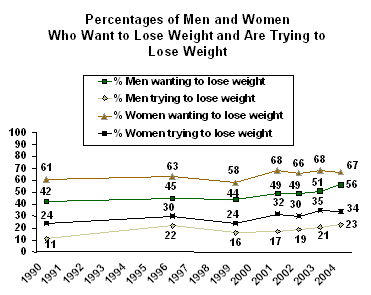
Though large numbers of both groups say they want to lose weight, relatively few are trying to do so. Currently, 23% of men say they are seriously trying to lose weight, compared with 34% of women. Again, this pattern has been found by Gallup in all of its measures over the past decade.
Among people classified as overweight but not obese, 73% say they want to lose weight, but just 34% are making a serious effort to do so. Similarly, among the obese, 97% say they want to lose weight, but just 51% are trying.
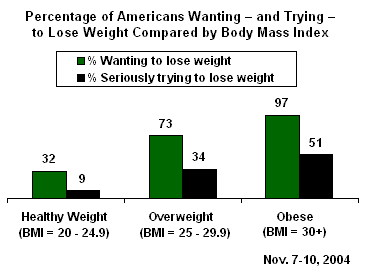
Among the people in the healthy weight category, the disconnect between desire and behavior is even more pronounced -- 32% say they want to lose weight, but only 9% are trying. No doubt, the fact that they are in the acceptable BMI range (and recognize that they are not really overweight) gives them less motivation to lose.
Only a small percentage of people in the underweight category either desire or are trying to lose weight.
Ideal Weight
Because many people want to lose weight, it's not surprising that about two-thirds of Americans (67%) cite an ideal weight that is below their actual weight -- 64% of men, 71% of women. On average, the ideal weight for men is 13 pounds lower than their reported actual weight, and for women it is just over 20 pounds lower.
But even if everyone reached their ideal weight, the BMI indicates that 36% of Americans would still be overweight, including 2% who would still fall into the obese category.
- Of the people who are overweight now (but not obese), as
measured by the BMI, 50% would still be overweight if they reached
their self-reported ideal weight.
- If people who are classified as obese reach what they say is
their ideal weight, the government would still classify 68% of them
as overweight, including 8% who would still be obese.
- Among those in the healthy weight category who reached their
perceived ideal weight, 5% would then be overweight, and 6% would
be underweight.
- Among the small number of underweight Americans who reached what they perceived to be their ideal weight, 26% would move from underweight to healthy weight, and another 5% would be overweight. The rest, 65%, would remain underweight.
Caution About the BMI
The National Institutes of Health (NIH) cautions against too much reliance on the BMI for an individual assessment of one's health. Here are some caveats from the NIH's Web site:
- "BMI does not directly measure percent of body fat, but it is a
more accurate indicator of overweight and obesity than relying on
weight alone."
- "One problem with using BMI as a measurement tool is that very
muscular people may fall into the 'overweight' category when they
are actually healthy and fit."
- "Another problem with using BMI is that people who have lost
muscle mass, such as the elderly, may be in the 'healthy weight'
category -- according to their BMI -- when they actually have
reduced nutritional reserves."
- "BMI, therefore, is useful as a general guideline to monitor trends in the population, but by itself is not diagnostic of an individual patient's health status."
It is as a general guideline to monitor the trends in the population that Gallup has used the BMI in this analysis.
Survey Methods
Results are based on telephone interviews with 1,016 national adults, aged 18 and older, conducted Nov. 7-10, 2004. For results based on the total sample, one can say with 95% confidence that the maximum margin of sampling error is ±3 percentage points.
20. How would you describe your own personal weight situation right now -- very overweight, somewhat overweight, about right, somewhat underweight, or very underweight?
|
|
Somewhat over-weight |
|
Somewhat under-weight |
|
|
|
|
% |
% |
% |
% |
% |
% |
|
|
2004 Nov 7-10 |
5 |
36 |
54 |
5 |
* |
* |
|
|
|
|
|
|
|
|
|
2004 Jul 8-11 |
5 |
39 |
50 |
5 |
1 |
* |
|
2003 Nov 3-5 |
4 |
37 |
53 |
5 |
1 |
* |
|
2003 Jul 7-9 |
4 |
39 |
50 |
5 |
1 |
1 |
|
2002 Nov 11-14 |
6 |
36 |
51 |
5 |
1 |
1 |
|
2002 Jul 9-11 |
6 |
34 |
55 |
5 |
* |
* |
|
2001 Nov 8-11 |
6 |
38 |
51 |
4 |
* |
1 |
|
2001 Jul 19-22 |
5 |
41 |
49 |
5 |
* |
* |
|
1999 Jul 22-25 |
4 |
35 |
53 |
6 |
1 |
1 |
|
1990 Oct 18-21 |
7 |
41 |
46 |
5 |
1 |
* |
|
* Less than 0.5% |
||||||
21. What is your approximate current weight?
|
|
124 lbs. or less |
125-149 lbs. |
150-174 lbs. |
175-199 lbs. |
200 lbs. and over |
No opinion |
Average weight |
|
% |
% |
% |
% |
% |
% |
|
|
|
National Adults |
|
|
|
|
|
|
|
|
2004 Nov 7-10 |
8 |
19 |
25 |
20 |
24 |
4 |
173 |
|
2003 Nov 3-5 |
8 |
21 |
21 |
22 |
24 |
4 |
174 |
|
2002 Nov 11-14 |
9 |
22 |
22 |
18 |
25 |
4 |
173 |
|
2001 Nov 8-11 |
8 |
20 |
24 |
22 |
22 |
4 |
171 |
|
2001 Jul 19-22 |
8 |
19 |
26 |
20 |
22 |
5 |
173 |
|
1999 Jul 22-25 |
11 |
19 |
25 |
20 |
20 |
4 |
170 |
|
1990 Oct 18-21 |
12 |
27 |
27 |
16 |
15 |
3 |
161 |
|
|
|
|
|
|
|
|
|
|
Men |
|
|
|
|
|
|
|
|
2004 Nov 7-10 |
* |
7 |
23 |
30 |
39 |
1 |
191 |
|
2003 Nov 3-5 |
1 |
7 |
19 |
34 |
38 |
1 |
195 |
|
2002 Nov 11-14 |
1 |
8 |
25 |
24 |
41 |
1 |
193 |
|
2001 Nov 8-11 |
1 |
8 |
22 |
33 |
35 |
1 |
189 |
|
2001 Jul 19-22 |
3 |
8 |
26 |
28 |
34 |
1 |
188 |
|
1999 Jul 22-25 |
1 |
6 |
27 |
31 |
33 |
2 |
190 |
|
1990 Oct 18-21 |
2 |
11 |
35 |
27 |
25 |
* |
180 |
|
|
|
|
|
|
|
|
|
|
Women |
|
|
|
|
|
|
|
|
2004 Nov 7-10 |
16 |
29 |
27 |
11 |
11 |
6 |
156 |
|
2003 Nov 3-5 |
15 |
34 |
23 |
10 |
11 |
6 |
153 |
|
2002 Nov 11-14 |
15 |
35 |
21 |
12 |
10 |
7 |
153 |
|
2001 Nov 8-11 |
15 |
31 |
26 |
11 |
11 |
6 |
153 |
|
2001 Jul 19-22 |
13 |
29 |
26 |
12 |
12 |
8 |
158 |
|
1999 Jul 22-25 |
20 |
32 |
24 |
9 |
8 |
7 |
150 |
|
1990 Oct 18-21 |
21 |
42 |
20 |
7 |
5 |
5 |
142 |
|
* Less than 0.5% |
|||||||
22. What is your approximate current height?
|
|
|
|
|
|
|
|
6'4" or taller |
|
|
|
% |
% |
% |
% |
% |
% |
% |
% |
|
|
|
National Adults |
|
|
|
|
|
|
|
|
|
|
2004 Nov 7-10 |
2 |
17 |
25 |
14 |
23 |
17 |
1 |
1 |
5'7" |
|
2003 Nov 3-5 |
4 |
13 |
26 |
15 |
23 |
15 |
3 |
2 |
5'7" |
|
2001 Nov 8-11 |
3 |
15 |
27 |
16 |
20 |
15 |
3 |
1 |
5'8" |
|
|
|
|
|
|
|
|
|
|
|
|
Men |
|
|
|
|
|
|
|
|
|
|
2004 Nov 7-10 |
* |
2 |
7 |
14 |
40 |
34 |
2 |
1 |
5'10" |
|
2003 Nov 3-5 |
* |
1 |
9 |
13 |
39 |
31 |
6 |
1 |
5'10" |
|
2001 Nov 8-11 |
-- |
1 |
7 |
17 |
36 |
31 |
7 |
1 |
5'11" |
|
|
|
|
|
|
|
|
|
|
|
|
Women |
|
|
|
|
|
|
|
|
|
|
2004 Nov 7-10 |
3 |
32 |
40 |
15 |
8 |
1 |
-- |
1 |
5'5" |
|
2003 Nov 3-5 |
7 |
24 |
41 |
18 |
7 |
1 |
-- |
3 |
5'4" |
|
2001 Nov 8-11 |
5 |
28 |
44 |
16 |
6 |
* |
* |
1 |
5'5" |
|
* Less than 0.5% |
|||||||||
BODY MASS INDEX (Q.21-22)
|
|
< 20 (under-weight) |
|
26-30 |
|
|
|
|
|
% |
% |
% |
% |
% |
% |
% |
|
|
National Adults |
|
|
|
|
|
|
|
|
2004 Nov 7-10 |
6 |
32 |
39 |
20 |
3 |
27 |
26 |
|
2003 Nov 3-5 |
4 |
36 |
35 |
20 |
5 |
27 |
26 |
|
2001 Nov 8-11 |
5 |
36 |
36 |
18 |
5 |
27 |
26 |
|
|
|
|
|
|
|
|
|
|
Men |
|
|
|
|
|
|
|
|
2004 Nov 7-10 |
2 |
28 |
50 |
18 |
2 |
27 |
26 |
|
2003 Nov 3-5 |
3 |
28 |
45 |
23 |
1 |
27 |
27 |
|
2001 Nov 8-11 |
3 |
32 |
46 |
17 |
2 |
26 |
26 |
|
|
|
|
|
|
|
|
|
|
Women |
|
|
|
|
|
|
|
|
2004 Nov 7-10 |
9 |
35 |
29 |
21 |
6 |
26 |
25 |
|
2003 Nov 3-5 |
6 |
43 |
26 |
17 |
8 |
26 |
24 |
|
2001 Nov 8-11 |
6 |
39 |
28 |
19 |
8 |
27 |
25 |
|
|
|
|
|
|
|
|
|
|
NOTE: Body mass index is a ratio of one's weight to their height. |
|||||||
40. Would you like to [ROTATED: lose weight, stay at your present weight, or put on weight]?
|
|
Lose weight |
Put on weight |
Stay at present |
No opinion |
|
% |
% |
% |
% |
|
|
National Adults |
|
|
|
|
|
2004 Nov 7-10 |
62 |
5 |
33 |
* |
|
2003 Nov 3-5 |
60 |
8 |
32 |
* |
|
2002 Nov 11-14 |
58 |
8 |
34 |
* |
|
2001 Jul 19-22 |
59 |
7 |
34 |
* |
|
1999 Jul 22-25 |
52 |
9 |
39 |
* |
|
1996 Feb 23-25 |
55 |
4 |
41 |
* |
|
1990 Oct 18-21 |
52 |
7 |
40 |
1 |
|
1957 Aug 29-Sep 4 |
35 |
11 |
49 |
5 |
|
1955 Jun 24-29 |
37 |
13 |
48 |
2 |
|
1954 Jul 2-7 |
35 |
14 |
50 |
1 |
|
1953 Feb 1-5 |
37 |
13 |
49 |
1 |
|
1951 |
31 |
17 |
50 |
2 |
|
|
|
|
|
|
|
Men |
|
|
|
|
|
2004 Nov 7-10 |
56 |
6 |
38 |
-- |
|
2003 Nov 3-5 |
51 |
12 |
37 |
* |
|
2002 Nov 11-14 |
49 |
11 |
40 |
* |
|
2001 Jul 19-22 |
49 |
12 |
39 |
0 |
|
1999 Jul 22-25 |
44 |
13 |
43 |
* |
|
1996 Feb 23-25 |
45 |
6 |
49 |
* |
|
1990 Oct 18-21 |
42 |
10 |
47 |
1 |
|
1957 Aug 29-Sep 4 |
25 |
14 |
56 |
5 |
|
1955 Jun 24-29 |
24 |
16 |
58 |
2 |
|
1954 Jul 2-7 |
26 |
16 |
58 |
* |
|
1953 Feb 1-5 |
10 |
20 |
68 |
2 |
|
1951 |
21 |
20 |
57 |
2 |
|
|
|
|
|
|
|
Women |
|
|
|
|
|
2004 Nov 7-10 |
67 |
4 |
29 |
* |
|
2003 Nov 3-5 |
68 |
4 |
28 |
|
|
2002 Nov 11-14 |
66 |
4 |
30 |
* |
|
2001 Jul 19-22 |
68 |
2 |
30 |
* |
|
1999 Jul 22-25 |
58 |
5 |
37 |
* |
|
1996 Feb 23-25 |
63 |
3 |
34 |
* |
|
1990 Oct 18-21 |
61 |
4 |
34 |
1 |
|
1957 Aug 29-Sep 4 |
45 |
8 |
42 |
5 |
|
1955 Jun 24-29 |
49 |
10 |
38 |
3 |
|
1954 Jul 2-7 |
45 |
12 |
42 |
1 |
|
1953 Feb 1-5 |
43 |
11 |
45 |
1 |
|
1951 |
44 |
12 |
43 |
1 |
|
* Less than 0.5% |
||||
41. What do you think is the ideal body weight for you, personally?
|
|
124 lbs. or less |
125-149 lbs. |
150-174 lbs. |
175-199 lbs. |
200 lbs. and over |
No opinion |
Average weight |
|
% |
% |
% |
% |
% |
% |
|
|
|
National Adults |
|
|
|
|
|
|
|
|
2004 Nov 7-10 |
13 |
30 |
26 |
19 |
10 |
2 |
156 |
|
2003 Nov 3-5 |
12 |
33 |
21 |
20 |
12 |
2 |
157 |
|
2002 Nov 11-14 |
15 |
28 |
24 |
18 |
11 |
4 |
157 |
|
2001 Jul 19-22 |
11 |
31 |
26 |
20 |
9 |
3 |
156 |
|
1999 Jul 22-25 |
13 |
31 |
23 |
19 |
12 |
3 |
157 |
|
1990 Oct 18-21 |
18 |
32 |
24 |
16 |
6 |
4 |
149 |
|
|
|
|
|
|
|
|
|
|
Men |
|
|
|
|
|
|
|
|
2004 Nov 7-10 |
2 |
6 |
35 |
37 |
19 |
1 |
178 |
|
2003 Nov 3-5 |
1 |
9 |
27 |
39 |
23 |
2 |
181 |
|
2002 Nov 11-14 |
1 |
8 |
31 |
34 |
24 |
2 |
181 |
|
2001 Jul 19-22 |
2 |
8 |
31 |
38 |
19 |
2 |
177 |
|
1999 Jul 22-25 |
* |
8 |
28 |
37 |
23 |
3 |
180 |
|
1990 Oct 18-21 |
1 |
10 |
41 |
33 |
12 |
3 |
171 |
|
|
|
|
|
|
|
|
|
|
Women |
|
|
|
|
|
|
|
|
2004 Nov 7-10 |
22 |
52 |
19 |
3 |
1 |
3 |
136 |
|
2003 Nov 3-5 |
22 |
55 |
16 |
3 |
1 |
3 |
135 |
|
2002 Nov 11-14 |
27 |
46 |
17 |
3 |
1 |
6 |
134 |
|
2001 Jul 19-22 |
20 |
51 |
22 |
3 |
* |
4 |
137 |
|
1999 Jul 22-25 |
25 |
52 |
17 |
3 |
1 |
2 |
136 |
|
1990 Oct 18-21 |
32 |
51 |
10 |
2 |
* |
5 |
129 |
|
* Less than 0.5% |
|||||||
COMBINED RESPONSES (Q.21/Q.41)
|
2004 Nov 7-10 |
National Adults |
Men |
Women |
|
|
% |
% |
% |
||
|
Under Ideal Weight |
11 |
13 |
8 |
|
|
More than 20 lbs. |
1 |
1 |
1 |
|
|
11-20 lbs. |
3 |
4 |
1 |
|
|
1-10 lbs. |
7 |
8 |
6 |
|
|
|
|
|
||
|
At Ideal Weight |
17 |
21 |
13 |
|
|
|
|
|
||
|
Over Ideal Weight |
67 |
64 |
71 |
|
|
1-10 lbs. |
23 |
23 |
24 |
|
|
11-20 lbs. |
17 |
20 |
16 |
|
|
21-50 lbs. |
20 |
18 |
21 |
|
|
More than 50 lbs. |
7 |
3 |
10 |
|
|
|
|
|
||
|
Undesignated |
5 |
2 |
8 |
|
|
|
|
|
||
|
Mean |
+16.6 |
+12.7 |
+20.4 |
|
|
Median |
+10 |
+10 |
+12 |
|
HISTORIC TREND: DIFFERENCE BETWEEN ACTUAL AND IDEAL WEIGHT
|
|
Mean |
Median |
|
|
|
|
|
National Adults |
|
|
|
2004 Nov 7-10 |
+16.6 |
+10 |
|
2003 Nov 3-5 |
+16.3 |
+10 |
|
2002 Nov 11-14 |
+15.5 |
+10 |
|
2001 Jul 19-22 |
+16.6 |
+10 |
|
1999 Jul 22-25 |
+11.8 |
+6 |
|
1990 Oct 18-21 |
+11.3 |
+5 |
|
|
|
|
|
Men |
|
|
|
2004 Nov 7-10 |
+12.7 |
+10 |
|
2003 Nov 3-5 |
+14.0 |
+7 |
|
2002 Nov 11-14 |
+12.4 |
+5 |
|
2001 Jul 19-22 |
+11.9 |
+5 |
|
1999 Jul 22-25 |
+9.8 |
+5 |
|
1990 Oct 18-21 |
+9.1 |
+5 |
|
|
|
|
|
Women |
|
|
|
2004 Nov 7-10 |
+20.4 |
+12 |
|
2003 Nov 3-5 |
+18.5 |
+10 |
|
2002 Nov 11-14 |
+18.6 |
+10 |
|
2001 Jul 19-22 |
+21.3 |
+10 |
|
1999 Jul 22-25 |
+13.6 |
+8 |
|
1990 Oct 18-21 |
+13.3 |
+8 |
|
|
|
|
|
Note: Positive numbers indicate over ideal weight, negative numbers indicate under ideal weight |
||
42. At this time are you seriously trying to lose weight?
|
|
Yes |
No |
No opinion |
|
% |
% |
% |
|
|
National Adults |
|
|
|
|
2004 Nov 7-10 |
29 |
71 |
* |
|
2003 Nov 3-5 |
28 |
72 |
* |
|
2002 Nov 11-14 |
24 |
75 |
1 |
|
2001 Jul 19-22 |
25 |
75 |
* |
|
1999 Jul 22-25 |
20 |
80 |
* |
|
1996 Feb 23-25 |
26 |
74 |
* |
|
1990 Oct 18-21 |
18 |
82 |
* |
|
1955 |
17 |
83 |
* |
|
1953 |
25 |
75 |
* |
|
1951 |
19 |
81 |
* |
|
|
|
|
|
|
Men |
|
|
|
|
2004 Nov 7-10 |
23 |
77 |
-- |
|
2003 Nov 3-5 |
21 |
79 |
* |
|
2002 Nov 11-14 |
19 |
80 |
1 |
|
2001 Jul 19-22 |
17 |
82 |
1 |
|
1999 Jul 22-25 |
16 |
84 |
* |
|
1996 Feb 23-25 |
22 |
78 |
* |
|
1990 Oct 18-21 |
11 |
88 |
1 |
|
|
|
|
|
|
Women |
|
|
|
|
2004 Nov 7-10 |
34 |
66 |
* |
|
2003 Nov 3-5 |
35 |
65 |
* |
|
2002 Nov 11-14 |
30 |
70 |
* |
|
2001 Jul 19-22 |
32 |
68 |
0 |
|
1999 Jul 22-25 |
24 |
76 |
* |
|
1996 Feb 23-25 |
30 |
70 |
* |
|
1990 Oct 18-21 |
24 |
76 |
* |
|
* Less than 0.5% |
|||